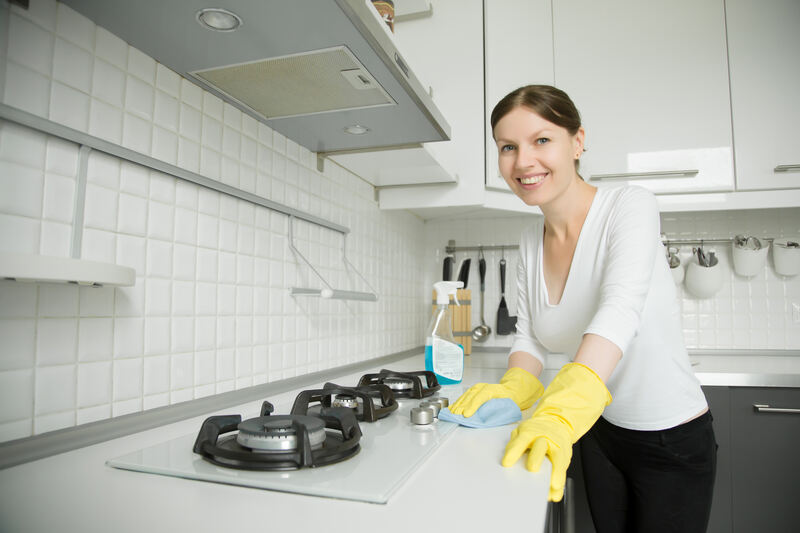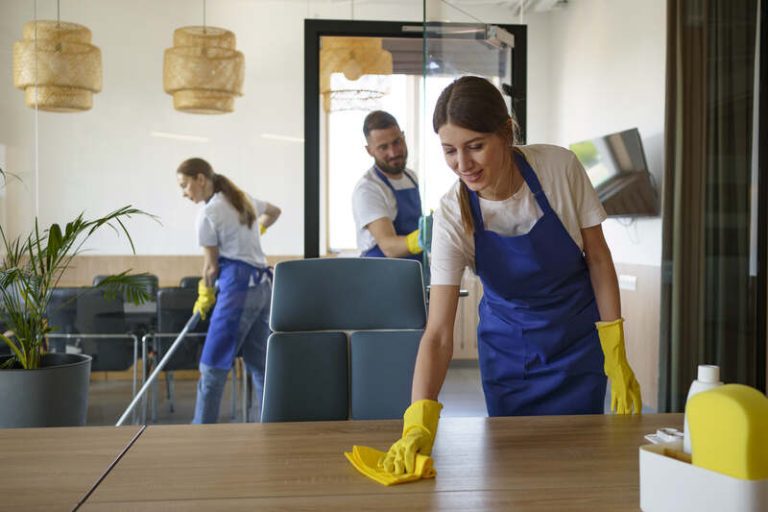Keeping your kitchen clean is essential to maintaining a healthy and organised space for cooking and eating. Therefore, it is important for you to have a kitchen cleaning checklist.
A kitchen cleaning checklist can help you to stay on top of the cleaning tasks that need to be done regularly. From essential items to steps to follow, this article will guide you on the importance of having a kitchen cleaning checklist, what items to include, how often to use it, and tips to keep your kitchen clean.
Let’s dive in and make your kitchen sparkle with this kitchen cleaning checklist!
Essential Items for a Kitchen Cleaning Checklist
A well-rounded kitchen cleaning checklist must include essential items such as effective cleaning supplies, protective gear for staff, and ample rubbish bags to manage waste efficiently.
a. Cleaning Supplies
Effective kitchen cleaning starts with having the right cleaning supplies, including degreasing spray, steel wool, a scrubbing brush, and cleaning gloves.
Each cleaning supply plays a crucial role in tackling different types of dirt and grime. Degreasing spray is perfect for cutting through tough kitchen grease, while steel wool is ideal for scrubbing away baked-on residues. Using a scrubbing brush helps reach corners and crevices, ensuring a thorough clean. Don’t forget to protect your hands with cleaning gloves to maintain hygiene while cleaning.
Proper usage of these supplies ensures effective cleaning results. For instance, spray the degreaser on surfaces, let it sit for a few minutes, then scrub with steel wool or the scrubbing brush. Rinse thoroughly and dry. Rotate these supplies regularly to avoid contamination and stock up to maintain a consistent cleaning routine.
b. Protective Gear
Protective gear such as cleaning gloves, hand soap, and hand sanitiser is essential for maintaining safety standards during kitchen cleaning tasks.
Each of these protective items plays a crucial role in safeguarding the well-being of kitchen staff members.
Cleaning gloves shield hands from harsh chemicals, hot water, and potential cuts or scrapes, reducing the risk of injuries. Hand soap is vital for thorough hand hygiene, eliminating germs and bacteria that could contaminate food surfaces. Hand sanitiser offers an additional layer of protection, especially in situations where access to soap and water is limited.
c. Trash Bags
Rubbish bags are vital for effective waste management, ensuring that rubbish is properly disposed of in line with the kitchen’s cleaning schedule.
Without durable rubbish bags, there is a risk of leaks and tears, leading to a messy and unhygienic kitchen environment. Regular waste disposal not only prevents foul odours but also minimises the chances of attracting pests. By prioritising proper waste management practices, such as recycling and composting, you can contribute to a cleaner and more organised kitchen space.
Steps to Follow for a Kitchen Cleaning Checklist
Following a structured kitchen cleaning checklist involves a series of comprehensive cleaning tasks that should be performed regularly to ensure consistency and accountability in maintaining a hygienic kitchen environment.
a. Clearing and Organising
The first step in any kitchen cleaning procedure is to clear and organize all surfaces, ensuring a clutter-free environment that facilitates effective cleaning.
Sorting through items, grouping similar things together, and creating designated spaces for each item is essential for maintaining an organized kitchen. By prioritizing what to keep, donate, or discard, it streamlines the process and reduces unnecessary clutter.
Properly storing utensils, pots, pans, and ingredients not only makes them easier to find but also prolongs their lifespan. Utilising storage solutions like cabinets, shelves, and drawer organizers enhances the functionality of the kitchen and improves workflow.
b. Wiping Down Surfaces
Wiping down surfaces, particularly worktops, is a crucial task in kitchen cleaning to ensure proper sanitisation and prevent the spread of germs.
When tackling this cleaning task, it’s important to use effective techniques to ensure a thorough job. Start by clearing the surface of any items, then use a damp cloth or sponge to wipe it down. For tougher stains or dirt, gentle scrubbing may be necessary. Remember to pay extra attention to areas that are frequently touched such as handles and knobs. Using appropriate cleaning agents is essential. Choose disinfectants or sanitisers that are specifically formulated for kitchen surfaces to effectively kill germs. This task not only enhances the cleanliness of your kitchen but also plays a significant role in maintaining a healthy environment for you and your family.
c. Cleaning Appliances
Cleaning appliances such as the dishwasher, fridge, and oven is essential to prevent the build-up of grime and ensure their efficient operation.
In terms of cleaning your dishwasher, start by removing the racks and utensil holders to access all areas. Use a mixture of white vinegar and bicarbonate of soda to clean the interior, then wipe down the exterior with a mild detergent and water.
For the fridge, regularly clean out expired food items and wipe down shelves with a solution of water and mild soap. Cleaning the oven involves removing the racks, spraying oven cleaner, and scrubbing away burnt-on residue for a sparkling finish.
Regular maintenance of these appliances is crucial for their longevity and efficiency. By cleaning them regularly, you not only ensure that they function optimally but also extend their lifespan. It is recommended to clean your appliances at least once a month to prevent the accumulation of dirt and grime, which can lead to malfunctions and inefficiency.
Using the right cleaning products is key to achieving excellent results without damaging your appliances. Always check the manufacturer’s instructions for recommended cleaning products to avoid using anything abrasive that could scratch surfaces or cause corrosion. Consider using natural cleaners like lemon and vinegar for a more eco-friendly approach to appliance cleaning.
d. Scrubbing the Sink
Scrubbing the sink is a key cleaning procedure that plays a vital role in maintaining kitchen hygiene and preventing contamination.
Thoroughly cleaning the sink involves removing food residues, grease, and bacteria buildup that can harbour germs and odours. Using a non-abrasive scrubbing pad or brush, apply a mixture of warm water and dish soap to scrub all surfaces of the sink. Don’t forget to scrub around the drain and tap the edges as well.
To achieve a sparkling clean finish, consider using white vinegar or bicarbonate of soda to tackle any stubborn stains or mineral deposits. These natural cleaning agents are effective in breaking down grime and leaving your sink shiny and fresh.
e. Disinfecting Countertops
Disinfecting worktops is a crucial step in kitchen cleaning to eradicate bacteria and maintain a safe food preparation area.
In terms of disinfecting worktops effectively, it’s essential to start by selecting the right cleaning supplies. Look for disinfectants that are specifically designed to kill germs and bacteria commonly found in kitchens. These products typically contain ingredients like bleach, hydrogen peroxide, or quaternary ammonium compounds.
Before applying the disinfectant, make sure to thoroughly clean the surfaces with soap and water to remove any visible dirt or grime. This will allow the disinfectant to work more efficiently. When applying the disinfectant, ensure thorough coverage by following the instructions on the product label. Avoid rushing through this step to guarantee that all areas of the worktop are properly treated. Consider using disposable disinfectant wipes for quick touch-ups throughout the day to maintain a clean and sanitary kitchen environment.
f. Cleaning Floors
Cleaning floors regularly is essential to adhere to hygiene rules and prevent slips and falls in the kitchen.
In terms of cleaning kitchen floors, different types call for different techniques. For tile floors, a mixture of warm water and mild detergent works well, while hardwood floors require a gentle cleaner specifically formulated for wood. For vinyl or linoleum floors, a solution of vinegar and water can effectively remove dirt and grime.
The frequency of this task also varies depending on usage, but as a general rule of thumb, kitchen floors should be swept or vacuumed daily and mopped at least once a week. Maintaining clean floors is crucial for kitchen safety, as spills and crumbs can attract pests and cause accidents in a high-traffic area like the kitchen.
g. Emptying and Cleaning the Refrigerator
Emptying and cleaning the fridge is crucial for maintaining food storage hygiene and preventing the build-up of spoiled food.
First, begin by removing all food items from the fridge, and discarding any expired or spoiled goods. Then, take out all the shelves, drawers, and bins to clean them separately with warm, soapy water.
Next, wipe down the interior walls and surfaces of the fridge using a solution of equal parts water and vinegar. Pay special attention to corners and crevices where spills tend to accumulate.
Regular maintenance not only extends the lifespan of your fridge but also helps to reduce the risk of contamination and foodborne illnesses.
Organise food items by category, placing raw meats on the bottom shelf to prevent drips onto other foods. Use airtight containers to store leftovers and prepped ingredients, maximising freshness and preventing odours from spreading. Label and date food containers to easily track expiration dates and avoid confusion about what is inside.
h. Sanitising Cutting Boards and Utensils
Sanitising cutting boards and utensils is a vital kitchen cleaning task to prevent cross-contamination and ensure safe food preparation.
There are several effective methods to properly sanitise cutting boards and utensils. One common method is to use a solution of warm water and bleach. Simply mix one tablespoon of bleach per gallon of water, soak the items for a few minutes, then rinse thoroughly.
Another option is to use a mixture of vinegar and water, which can help eliminate bacteria and odours. Using a dishwasher with a sanitised setting is a convenient way to ensure thorough cleaning. It’s important to remember to regularly replace cutting boards that show signs of wear and tear to maintain a hygienic kitchen environment.
How Often Should You Use a Kitchen Cleaning Checklist?
The frequency of using a kitchen cleaning checklist should be based on a structured cleaning schedule, incorporating daily, weekly, and monthly tasks to maintain optimal cleanliness.
In terms of daily tasks, wiping down worktops, sinks, and hobs is essential to prevent the build-up of grime and bacteria. Ensuring dishes are washed and put away promptly can also contribute to a tidy kitchen environment.
Moving on to weekly chores, cleaning the fridge, microwave, and oven can help eliminate odours and maintain food freshness. Sweeping and mopping the floors should not be overlooked to keep the kitchen floors free from dirt and spills.
There you have it, a complete explanation about kitchen cleaning checklist. Now, you know what needs to be included in the kitchen cleaning checklist, right?
However, maintaining a spotless kitchen can be time-consuming and challenging. For a truly deep clean, it’s best to rely on professional services.
At TEKA Cleaning, we offer comprehensive residential cleaning and commercial cleaning services tailored to your needs. Our experienced team uses advanced techniques and high-quality products to ensure your kitchen is not only clean but also hygienic and safe.
Don’t compromise on cleanliness. Contact TEKA Cleaning today to book our residential or commercial cleaning services. Call us at 01233 751 544 or visit our website to schedule an appointment. Trust the experts to keep your kitchen in top condition.
Read also:










